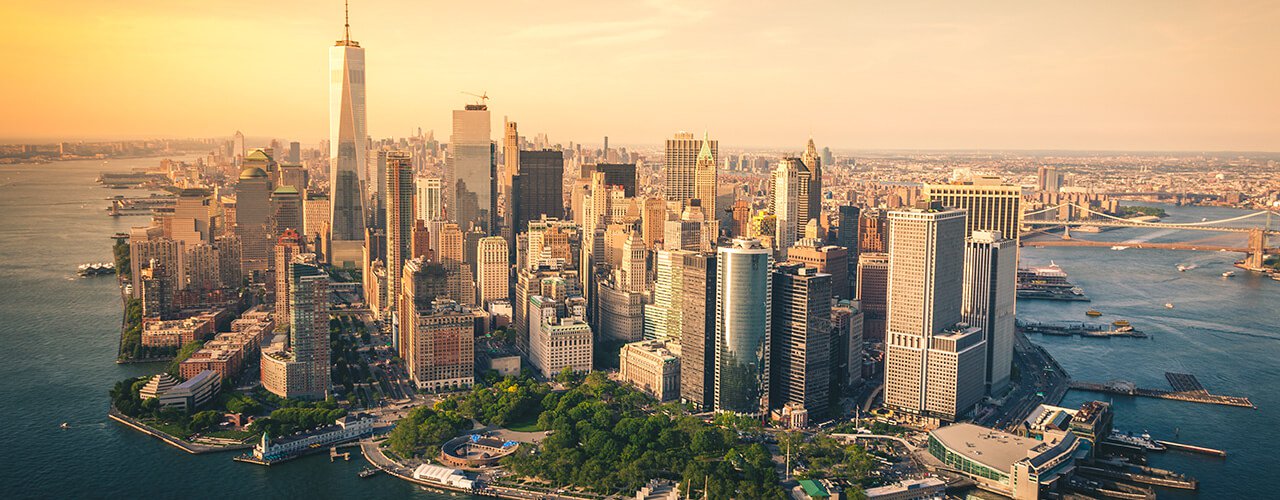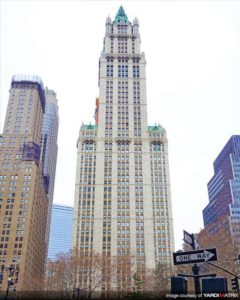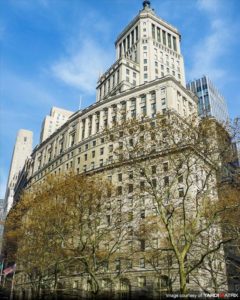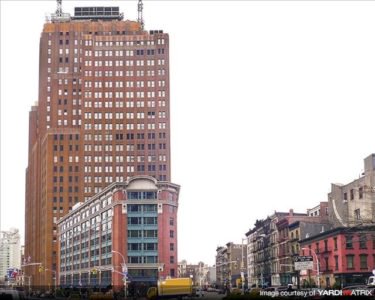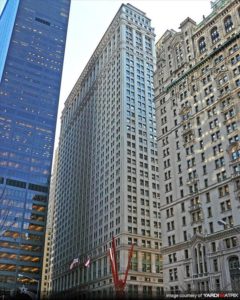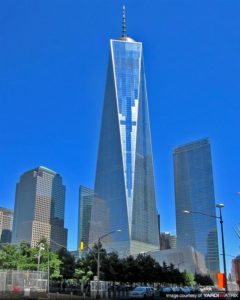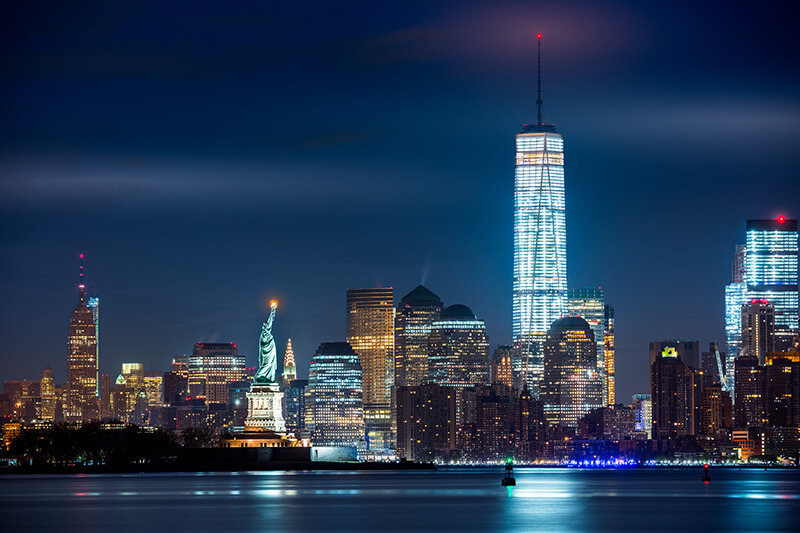New York has long been a vibrant city with persistent energy and a unique competitive streak. Growing from a humble Seventeenth Century settlement into America’s largest metropolis, NYC has developed many defining features, the most distinguished of which is perhaps its impressive skyline, which boasts the largest collection of skyscrapers in the Western Hemisphere.
We continue our skyline evolution series with a multi-part look at the growth of the NYC cityscape. In this first part, we map the upward evolution of Downtown Manhattan from the early 1900s through today. Under the ever inspiring watch of Lady Liberty, Lower Manhattan stretches below 14th street, from the Hudson to the East River, a checkerboard of narrow glass canyons and shaded streets lined with townhouses.
Check out the video below and read on to learn more about the evolution of Downtown Manhattan.
Today’s dense clusters of Lower and Midtown Manhattan are the result of cycles of boom and bust throughout the history of the American skyscraper. At the southern tip of the island, Wall Street skyscrapers stand in oddly satisfying contrast to the old commercial buildings of the South Street Seaport historic district, which has political as well as commercial significance: from 1785 through 1789, Congress met at Federal Hall, the same building in which George Washington was sworn in as the first President of the United States on April 30th, 1789.
In the 230 years since it served as the de-facto capital, Manhattan grew from a city of 28,000 people walking on crooked, narrow, unpaved, and often unlit streets lined by modest buildings only a few stories tall, to the 1.7-million-strong borough that sports a glimmering and sky-piercing cityscape unlike any other in the world.
The Early 1900s: Turning On The Lights And Recognizing Air Rights
The New York Stock Exchange building – the greatest symbol of trade in the land – opened its doors at 11 Wall St., in April 1903, and its grand façade still offers an imposing view, even from a block away. The Singer Sewing Machine Co. headquarters building opened in 1908, part of a cluster of high-rises that were the tallest in the world at the time. During a period when electric lighting was a novelty, the Singer was the second notable construction to use exterior illumination, mainly for advertising purposes.
In April 1913, President Woodrow Wilson pushed a button in Washington, and 80,000 lights came on at the Woolworth Tower on Broadway in Manhattan, signaling that “New York’s newest heaven-kissing tower was opened formally for service.” Before 1920, several influential and innovative high-rises joined the skyline. The 7-story stepped pyramid atop 14 Wall St., built 1912, became a symbol of the Financial District and was broadly copied in 1920s’ architecture. The Municipal Building, built 1914, was the first to incorporate a subway station into its base – Chambers Street station.
The 38-story steel-frame Equitable Building (1915) rose directly from the street line, without any setbacks. Its massive figure encompassed 1.2 million square feet of rentable space, could house 16,000 office workers, and was equipped with state-of-the-art elevators, ventilation and heating systems. To its owners, it was one of the most beautiful buildings on the continent. To New Yorkers, it was a behemoth that blocked out the sun, and it sparked a public outcry that led to the adoption of the 1916 Building Zone Resolution, the first of its kind, which would thereafter regulate the size and bulk of any new construction.
A flurry of beaux-arts style stepped-façade towers cropped up across Lower Manhattan during the 1920s. Broadway, Pine, and Wall Street became home to several towers taller than 400 feet, each more imposing than the last: The Barclay-Vessey tower, currently the Verizon Building, the Equitable Trust Co. headquarters at the intersection of Broad and Wall streets – the most important street corner in American finance, at the time – currently a luxury residential condominium dubbed Downtown by Philippe Starck, and the Transportation Building at 225 Broadway, just to name a few.
The Standard Oil Co. headquarters building at 26 Broadway rose 520 feet tall upon completion in 1924. Boasting the tallest tower at the tip of the island, the building featured a beacon that guided ships toward the harbor and was designed to be visible to all those who disembarked, drawing them into the city.
Roaring 20s LoMa Building Energy Spills Into 1930s
The early 1930s marked the completion of several tall orders on which work started before the Great Depression hit. Manhattan’s Financial District was so crowded with building activity, that there was no room to store materials for the ambitious project underway at 40 Wall Street, originally the Manhattan Co. building. Consequently, engineers scrambled for solutions and managed to get the 927-foot-tall tower built in just 11 months.
Outside the then-densifying Financial District, the terracotta-clad figure of the AT&T headquarters at 32 Avenue of the Americas rose 549 feet in TriBeCa. The 1.2 million-square-foot edifice was home to technical offices and equipment for the company’s transatlantic communications and remains a massive interconnection hub to this day.
20 Exchange Place opened for business in February 1931, with over 30,000 people attending the opening day ribbon-cutting ceremony. The tower still houses a breathtaking collection of mural art that depicts the history of New York City up to that time.
In 1932, the 952-foot-tall tower at 70 Pine was completed. One of the last Jazz Age towers on Wall Street, and the first to employ a double-deck elevator system, the slender cloud-piercing silhouette marked the shift in Manhattan architecture that would follow in step with the changes in the economy. It remained Lower Manhattan’s tallest building until the World Trade Center snatched the title in 1973.
1960s: The Lower Manhattan Revival
New York City‘s penchant for renewal is visible in its ever-changing skyline. With patience and fortitude, New Yorkers built their way out of the Great Depression and World War II. In the urban renewal plan of the mid-1960s, the Sky Boys were back at work, high upon the girders.
David Rockefeller’s vision of an International Style skyscraper that would contrast the multitude of Nineteenth-century spires dotting the Lower Manhattan Skyline materialized in 1963 in the form of the 28 Liberty office tower, which rose proudly 813 feet tall. The mighty Singer Building and the City Investing Building were razed in 1968, to make room for One Liberty Plaza, completed 1973. Derelict warehouses by the Hudson gave way to the Twin Towers (1972 and 1973), an impressive 110 floors each, housing international business and finance. Towering over 1,300 feet above the city, the World Trade Center stretched taller than any other building on the planet, reigning over the city that had truly become the center of global finance and trade.
Skyscrapers filled the cityscape like never before during the great American building boom of the 1980s. The once frighteningly massive Equitable Building was muted and modest among towers that topped out above 500 feet every few months. Manhattan was not only getting taller, it had also gotten wider. The 1.2 million cubic yards of material that was excavated in the construction of the WTC was used to extend the shoreline 700 feet into the Hudson, running roughly six blocks in length. Battery Park City was born and soon after became home to the World Financial Center, currently Brookfield Place.
New Millennium, New New York
The Millennium Point tower opened in January 2002 at the southern tip of Battery Park City. Property owner Millennium Partners donated a space on the ground floor to serve as permanent home to the Skyscraper Museum, which collects and preserves invaluable artifacts of high-rise history, in celebration of New York’s rich architectural heritage.
Since the start of the new millennium, additions to the Lower Manhattan skyline are a fresh shift in architecture, rising to dizzying heights in new shapes, employing new technologies, and incorporating novel amenities. New York by Gehry and 50 West add to the city’s legacy of architectural innovation by reinventing the Manhattan skyscraper style. 7 WTC is the city’s first LEED Gold-certified commercial building. An urban pine forest grows on the fifth floor of 101 Warren St., made up of 101 trees.
New Yorkers have always taken great pride in their toughness and resilience, defining traits that have also been reflected in the evolution of the city’s skyline. Today, nothing exemplifies that spirit more than the Freedom Tower. Completed in 2014, One World Trade Center stands 1776 feet tall, a celebratory nod to the year that the Declaration of Independence was signed. Its spire shining every night, the tallest building in the country watches over the harbor, over Lady Liberty, over New York City.
Methodology
For our Lower Manhattan Skyline Evolution video, we turned to Yardi Matrix and Skyscrapercenter data and compiled a list of buildings that are at least 400 feet tall and located in Manhattan, below 14th Street. No building classes were excluded. Additional proprietary research was conducted for the body of the article.
The author would like to thank Derek Hall for the helpful and inspiring discussions on this topic.

